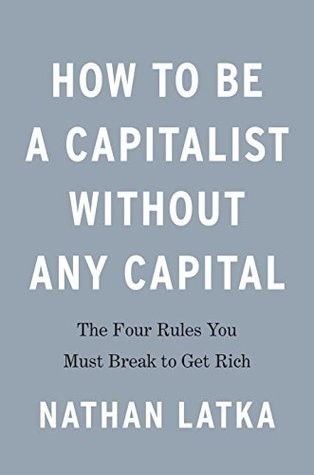More on this book
Community
Kindle Notes & Highlights
by
Nathan Latka
Read between
September 6, 2020 - December 14, 2021
my only rule is that you’re always pursuing three new opportunities at the same time.
You won’t have time to work on three huge, time-consuming projects at once. So focus 80 percent of your time on one project—the one that brings in the most money or that has the potential to be your biggest earner. Split the other 20 percent of your time between the two remaining ventures.
Every successful entrepreneur has copied,
If you don’t copy these free lessons, you’ll have to do what those with less knowledge do: pay to learn the lessons yourself.
If you’re launching a digital product like a podcast or YouTube channel, you have to troll Patreon.com.
Patreon also lets me see how the top-grossing podcasters communicate with their fans,
So set big, audacious goals, then forget the goals and focus on creating a system to produce the outcome you want not just once, but over and over again.
Systems thinking requires you to give up making money today in exchange for taking the time, energy, and sweat equity to set up systems that will do the work for you in the future.
Build systems around the things that take up most of your time. Sadly,
After you think you have a process documented accurately, print it off and take a trip to your local coffee shop. Then go test your system:
Time Blindness is another common oversight. We always project that things can be done faster than they actually can be done.
identifying one activity that triggers a system or a procedure,
Inputs: What do you have to feed the system to make it work?
The New Rich go to extensive lengths to clearly define inputs, procedures, and outputs, then always study their stocks and look for feedback loops that can save them time and make them more money.
Aaron (Piper Creative
selling their churned leads’ contact info to a lower-priced competitor
Make sure the systems you’re spending most of your time and money on scaling have a direct correlation to additional cash flow,
So be hyperintentional about where you’re spending your time and ruthlessly kill any systems that don’t have a direct correlation to growing your bank account.
The Outsiders by William N. Thorndike Jr. is a collection of eight stories from eight CEOs who set up systems that provided the highest capital returns in history.
Forget trying to appeal to the masses. Look at what the masses are going after, and then sell into the market that others have built around it.
while everyone’s spending money on fidget spinners, you might sell the “Fidget Spinner Sticker Kit.” While Amazon pulls a profit from third-party sellers, you might create an inventory-tracking program for those sellers.
the wealthiest people during the gold rush were not the gold miners. They were the people who sold pickaxes to the gold miners.
Sell add-ons for massively popular items.
Read news headlines each morning in a new way.
So instead of buying into cryptocurrencies, or doing your own ICO (initial coin offering), maybe you can create a dashboard for people to track ICOs.
Look at other marketplaces.
Leverage online learning platforms.
Eavesdrop on the influencers.
Look at what’s trending on Kickstarter campaigns and other crowdfunding sites.
Scan Patreon.com to see which digital products are hot.
Use Siftery.com to see what tools companies are paying to use inside their own businesses.
once you’ve validated your idea, you don’t have to jump through hoops to convince people it’s worthwhile.
Turner knew advertisers—the gold miners—were eager to reach consumers through TV.
He figured out what pickaxes he could sell (advertising) to the gold miners (advertisers) who were eager to profit from a hot, growing advertising space
think about how you can work a liability into your growth plan.
your ability to solve that liability, you can unlock loads of value.
Play on your playing field and make sure you have at least some expertise there.
say, “My show will have a million downloads by X date.” Experts and people you want to connect with will love that kind of confidence.
use your persuasion muscle for things that directly correlate to freeing up your time.
People today are less rational and more emotional than ever, but it’s your decision whether to use that opportunity for good or for bad.
The key is to tell a story that taps into fear—one that says, “This could happen to you.” Then sell businesses or consumers the vitamin.
Current events are fodder for new what-if fears, too.
Fear of Losing Freedom: The entire market of productivity tools feeds off this fear.
We’re afraid of somebody else controlling us—controlling our time,
Your odds of success spike if whatever you’re selling taps into multiple fears:
one of the reasons you lose negotiations is when you fear you’re going to lose the negotiation. That’s why it’s best to start negotiations when that fear doesn’t exist.
I want you to negotiate when you don’t have to.
Do it when you don’t need the help.
Once I’ve taken the conversation to the finish line and know my options,


